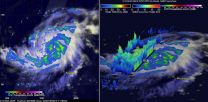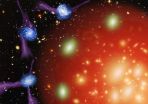Researchers discover 'swing-dancing' pairs of electrons
Findings set the stage for room-temperature superconductivity and the transformation of high-speed rail, quantum computers
2015-05-13
(Press-News.org) PITTSBURGH -- A research team led by the University of Pittsburgh's Jeremy Levy has discovered electrons that can "swing dance." This unique electronic behavior can potentially lead to new families of quantum devices.
Superconductors, materials that permit electrical current to flow without energy loss, form the basis for magnetic resonance imaging devices as well as emerging technologies such as quantum computers. At the heart of all superconductors is the bunching of electrons into pairs.
Levy, Distinguished Professor of Physics and Pittsburgh Quantum Institute director, has discovered a long-postulated phase in which electrons form pairs but do not reach a superconducting state. The discovery provides fundamental new insights into a mechanism that could one day be used to design a material that is superconducting at room temperature.
Such a breakthrough would radically transform an array of technologies such as high-speed trains, energy-efficient power transmission, and computers that operate with negligible power requirements. The work, done in collaboration with researchers from the University of Wisconsin-Madison and the U.S. Naval Research Laboratory, will be published May 14 in the journal Nature.
One way to understand this novel state is to extend an analogy first articulated by J. Robert Schrieffer, who shared the 1972 Nobel Prize in Physics for the theory of superconductivity. In a superconductor, the motion of paired electrons is highly coordinated, similar to waltzing couples on a dance floor. In the "normal" or non-superconducting state, electrons move independently, bumping into one another occasionally and dissipating energy. What the new research has identified is an in-between state where the electrons form pairs, but each pair moves independently. One may regard the electron pairs as "swing dancing" where dancing pairs hold hands but do not move in any synchronized fashion.
The first theory to describe how electrons pair without forming a superconducting state was published by David M. Eagles in 1969. Lead author and research assistant professor in the Levy lab, Guanglei Cheng, described how the theory was proven right: "The breakthrough comes from the technological advancement to fabricate superconducting single-electron transistors at an oxide interface--a technology that allows us to count electrons and pairs one by one. And this is just the beginning. We now have a novel platform to study the fascinating electron-electron correlations at nanoscale dimensions."
INFORMATION: END
ELSE PRESS RELEASES FROM THIS DATE:
2015-05-13
The type of perfectionist who sets impossibly high standards for others has a bit of a dark side. They tend to be narcissistic, antisocial and to have an aggressive sense of humor. They care little about social norms and do not readily fit into the bigger social picture. So says Joachim Stoeber of the University of Kent in the UK, who compared the characteristics of so-called other-orientated perfectionists against those of perfectionists who set the bar extremely high for themselves. The study is published in Springer's Journal of Psychopathology and Behavioral Assessment.
Perfectionism ...
2015-05-13
Typhoon Dolphin (strengthened overnight on 5/12 from Tropical Storm status) formed south of Pohnpei in the western Pacific Ocean on May 7, 2015. Dolphin's power has oscillated from a weak tropical depression to typhoon intensity over the past five days. Dolphin is now an intensifying typhoon headed westward.
The GPM core observatory satellite flew over Dolphin on May 12, 2015 at 2301 UTC. At that time Dolphin's wind speeds were estimated at about 65 kts (75 mph). Rainfall collected by GPM's Microwave Imager (GMI) showed that rain was falling at a rate of over 47 mm (1.9 ...
2015-05-13
As murder mysteries go, it's a big one: how do galaxies die and what kills them? A new study, published today in the journal Nature, has found that the primary cause of galactic death is strangulation, which occurs after galaxies are cut off from the raw materials needed to make new stars.
Researchers from the University of Cambridge and the Royal Observatory Edinburgh have found that levels of metals contained in dead galaxies provide key 'fingerprints', making it possible to determine the cause of death.
There are two types of galaxies in the Universe: roughly half ...
2015-05-13
If you walk into a dark room, you can still find your way to the light switch. That's because your brain keeps track of landmarks and the direction in which you are moving. Fruit flies also boast an internal compass that works when the lights go out, scientists at the Howard Hughes Medical Institute's Janelia Research Campus have discovered. Their findings suggest that dissecting how fruit flies navigate through the world could help researchers understand how humans and other mammals achieve that task.
In our brains, several kinds of neurons help us get and keep our bearings. ...
2015-05-13
Humans concerned about climate change are working to find ways of capturing excess carbon dioxide (CO2) from the atmosphere and sequestering it in the Earth. But Nature has its own methods for the removal and long-term storage of carbon, including the world's river systems, which transport decaying organic material and eroded rock from land to the ocean.
While river transport of carbon to the ocean is not on a scale that will bail humans out of our CO2 problem, we don't actually know how much carbon the world's rivers routinely flush into the ocean - an important piece ...
2015-05-13
Antipsychotic medication use during pregnancy does not put women at additional risk of developing gestational diabetes, hypertensive disorders or major blood clots that obstruct circulation, according to a new study led by researchers at Women's College Hospital and the Institute for Clinical Evaluative Sciences (ICES).
The study, published today in BMJ, is the largest to date to examine possible links between newer antipsychotic medications -- such as quetiapine, olanzapine and risperidone -- and medical conditions that often develop during pregnancy or with use of older ...
2015-05-13
Fermions are the building blocks of matter, interacting in a multitude of permutations to give rise to the elements of the periodic table. Without fermions, the physical world would not exist.
Examples of fermions are electrons, protons, neutrons, quarks, and atoms consisting of an odd number of these elementary particles. Because of their fermionic nature, electrons and nuclear matter are difficult to understand theoretically, so researchers are trying to use ultracold gases of fermionic atoms as stand-ins for other fermions.
But atoms are extremely sensitive to ...
2015-05-13
Pregnant women who undergo general surgical procedures appear to have no significant difference in postoperative complications compared with women who are not pregnant, according to a report published online by JAMA Surgery.
Historical data show that about 1 in 500 pregnant women require nonobstetric surgery, according to the study background.
Robert A. Meguid, M.D., M.P.H., of the University of Colorado Anschutz Medical Campus, Aurora, and coauthors analyzed data from the American College of Surgeons' National Surgical Quality Improvement Program from 2006 through ...
2015-05-13
CHICAGO (May 13, 2015): The annual number of liver transplantation operations increases when transplantation centers are concentrated in geographic areas that are highly competitive, according to findings from a new study published as an "article in press" in the Journal of the American College of Surgeons (JACS). The study, believed to be the first one to demonstrate a link between the volume of liver transplantation and competition for organs and geographic density, will appear in the print edition of the Journal this summer.
Researchers from the Department of Surgery ...
2015-05-13
WASHINGTON - The tendency for veterans with post-traumatic stress disorder to lash out in anger can be significantly amplified if they are also depressed, according to research published by the American Psychological Association.
"Our study findings should draw attention to anger as a major treatment need when military service members screen positive for PTSD or for depression, and especially when they screen positive for both," said lead author Raymond Novaco, PhD, professor of psychology and social behavior at the University of California, Irvine. The study appeared ...
LAST 30 PRESS RELEASES:
[Press-News.org] Researchers discover 'swing-dancing' pairs of electrons
Findings set the stage for room-temperature superconductivity and the transformation of high-speed rail, quantum computers

